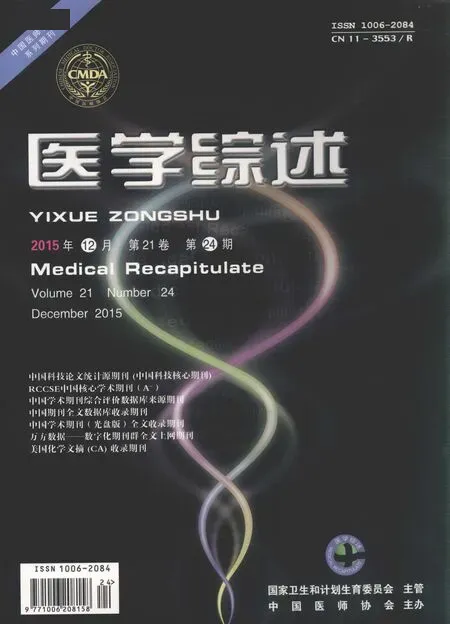树突状细胞的生物功能与慢性肝病研究进展
赵 娟,朱孟华,薄挽澜(综述),羊轶驹(审校)
( 1. 哈尔滨医科大学附属第一医院消化内科,哈尔滨 150001; 2.哈尔滨医科大学附属第四医院消化内科,哈尔滨 150001;
3.海南省农垦三亚医院消化内科,海南 三亚 572009)
树突状细胞的生物功能与慢性肝病研究进展
赵娟1△,朱孟华1,薄挽澜2(综述),羊轶驹3※(审校)
(1. 哈尔滨医科大学附属第一医院消化内科,哈尔滨 150001; 2.哈尔滨医科大学附属第四医院消化内科,哈尔滨 150001;
3.海南省农垦三亚医院消化内科,海南 三亚 572009)
摘要:树突状细胞(DC)是当前已知的人体内功能最强大的专职抗原呈递细胞,能唯一有效活化初始型T细胞,是机体免疫应答的启动者,是连接固有免疫和适应性免疫的关键纽带。研究证明,DC发育及功能的动态变化与机体免疫状态和临床结局相关。此外,目前细胞免疫治疗已进入临床研究阶段。该文就DC的生物学功能特点与慢性肝脏疾病的发生、进展之间的关系及治疗性DC肿瘤疫苗的免疫学基础予以综述。
关键词:慢性肝病;树突状细胞;免疫学功能;树突状细胞肿瘤疫苗
1973年,Steinman和Cohn[1]发表了《Identification of a Novel Cell Type in Peripheral Lymphoid Organs of Mice》,向全球公布,他们在脾脏细胞中分离出的一群黏附细胞,因其成熟时能伸出许多树突样或伪足样突起,故命名为树突状细胞(dendritic cells,DC)。2011年Steinman荣获诺贝尔生理学或医学奖[2]。DC的生物学功能特点与慢性肝脏疾病的发生、进展关系密切。肝脏疾病患者机体免疫功能低下或产生免疫耐受与患者DC的功能缺陷相关。DC免疫治疗具有主动性免疫、特异性强、持续时间久及不良反应弱等特点。现就DC在肝脏疾病中的特点及在治疗方面的研究进展予以综述。
1DC的生物学特点
1.3DC的表面分子体内大部分DC处于未成熟状态,低水平表达协同刺激分子及黏附分子,激发混合淋巴细胞反应的能力较低[5]。而成熟DC除高水平表达多种协同刺激分子(如CD80/B7-1、CD86/B7-2、CD40)及黏附分子(如细胞间黏附分子1、2、3和淋巴细胞功能相关抗原1、3),还丰富表达主要组织相容性复合体(major histocompatibility complex,MHC)-Ⅰ类和MHC-Ⅱ类分子。其中,协同刺激因子通过CD80/B7-1、CD86/B7-2与T细胞表面的相应配体CD28和细胞毒T淋巴细胞相关抗原4相互作用,提供活化T细胞的第二信号,激活T细胞,并使其产生白细胞介素(interleukin,IL)2、IL-6、干扰素γ(interferon γ,IFN-γ)、粒细胞-巨噬细胞集落刺激、肿瘤坏死因子α等大量细胞因子;随着向淋巴器官迁移,DC进一步成熟,不仅形态学发生改变,且MHC-Ⅱ、CD80/B7-1、CD86/B7-2等分子也发生上调,混合淋巴细胞反应增强[6]。可见,DC是目前发现的唯一能活化未致敏的初始型T细胞的抗原呈递细胞。
CD1a和CD83是DC的两个重要的膜表面标志分子。CD1a主要表达于人胸腺细胞,是鉴定人外周血与骨髓中DC的最好标记[7]。CD83是成熟DC所特有的膜表面标志,CD83又称为HB15,相对分子质量约43 000,属于免疫球蛋白超家族,其配体及功能尚未研究清楚[8]。
成熟DC活化初始T细胞需要双信号刺激。DC表面的MHC类分子/抗原肽复合物与T细胞(抗原)受体结合,传导抗原特异性刺激,此为第一信号;DC与T细胞间协同刺激分子的结合,以传导非抗原特异性的共刺激,此为第二信号。两者缺一不可,缺乏第二信号而仅有抗原特异性刺激信号,可导致T细胞无能甚至凋亡,也是机体免疫耐受及肿瘤发生的原因。
当DC用于抗肿瘤、感染的免疫治疗时,可以选择性诱导DC的协同刺激分子表达和活性,使T细胞活化增殖能力进一步增强,提高机体抗肿瘤、感染的免疫应答;当DC用于移植免疫时,可以选择性抑制DC上协同刺激分子表达和活性,阻断T细胞活化的非抗原性共刺激信号,诱导T细胞无能和凋亡,使机体产生免疫耐受。可见,在机体中DC的免疫应答呈双向性,对DC免疫功能的有效调节是治疗疾病的关键。
2DC的免疫学功能
由此可见,DC不仅能激活免疫应答参与机体抗病原体的正性免疫调节,还参与机体的免疫耐受,在机体免疫中起着正反双向调节作用,在抗感染性疾病、抗肿瘤免疫、自身免疫疾病和移植免疫等生理病理过程中发挥重要的免疫介导作用。
3DC与慢性肝脏疾病
3.1DC与病毒性肝炎
研究表明,慢性HBV患者的DC中存在HBV DNA,导致病毒逃避免疫攻击,机体形成慢性感染。近期,体外试验显示,乙型肝炎表面抗原可被循环mDC内化,导致DC的功能缺陷且DC病毒负载量也减少[16]。
在评估乙型肝炎患者的疾病进展方面pDC比mDC敏感,而pDC在感染的早期阶段减少,mDC在晚期阶段减少。在接受阿德福韦酯的治疗后,外周血中mDC数目增多是治疗有效反应的标志;与健康对照组比较,CD80和CD86在乙型肝炎患者中的数量显著减少,说明慢性乙型肝炎感染可导致DC功能降低和T细胞活性受抑制[18]。
Leone等[23]研究报道,HCV持续感染的患者循环中mDC及pDC的细胞数量低于健康对照组和自发性清除HCV感染者。但是提取HCV持续感染患者的DC,在体外刺激成熟,DC表现出的抗原摄取能力、共刺激分子的表达能力及细胞因子的生成量均是正常的。相比之下,它们在刺激成熟后并没有展现出从免疫蛋白酶体到标准蛋白酶体亚基表达的巨大转换,也没有表现出抗原肽相关转运蛋白体的上调。也就是说,DC中蛋白酶体降解抗原功能的失调,使其对T细胞活化能力降低,导致免疫耐受。
另有研究显示[24],慢性HCV感染者循环DC数目减少,但在肝脏中DC数目是增加的,且肝脏mDC/pDC高于循环血,循环DC的减少更可能是由于它们迁移到肝脏炎症区域,提示mDC优先迁移。这一发现可被理解为慢性HCV感染者DC主动交换和肝内外分布不平衡是导致循环DC减少的关键原因。
3.2DC和肝纤维化肝纤维化是各种病因引起的慢性肝损伤的肝脏瘢痕反应,是肝脏中常见的生理反应,是肝硬化的早期阶段,具有可逆性。损伤后细胞外基质(extracellular matrixc,ECM)的沉积导致肝细胞重构,最终导致肝硬化。ECM主要成分是胶原蛋白、蛋白聚糖、层粘连蛋白、纤维连结蛋白等,肝星状细胞是ECM的主要来源。肝星状细胞的激活是肝纤维化的重要环节,同时各种炎性细胞及其炎性因子在纤维化中也起关键作用。此外,DC可能通过肿瘤坏死因子α调节炎症环境来调控肝纤维化的发生,并可调控多种纤维化生成细胞的数量及活性,因此可以间接调控肝纤维化[25]。
另有研究表明,肝脏纤维化还涉及ECM重构[26]。基质金属蛋白酶是一种重要的钙依赖性蛋白酶,该酶可降解ECM的胶原与非胶原成分,DC参与了分泌基质金属蛋白酶,可降解ECM使组织结构疏松,导致DC的肝外迁移,DC的迁移有助于其适应性免疫应答反应的表达[27]。
4DC的临床应用
治疗性疫苗的设计方案是多样的,其共同特征及疫苗接种的关键步骤是T细胞对于肿瘤抗原的有效呈递。因为DC是最有效的抗原呈递细胞,利用它们在分类和可塑上的多样性,可对治疗性疫苗做出很大改进[36]。
5展望
DC与慢性肝脏疾病的发生、进展息息相关。对DC的生物学特点及效应的深入研究为治疗性DC疫苗的发展策略打开了新渠道。以DC为代表的细胞免疫治疗能恢复免疫功能和调节免疫失衡,可有效清除手术、放化疗后残余的癌细胞及微小病灶,预防肿瘤的复发和转移,可弥补手术、放疗及化疗等传统疗法的弊端。显而易见,致力于治疗性DC疫苗的研究令人振奋,其在慢性肝病治疗方面具有广阔的临床应用前景。
参考文献
[1]Steinman RM,Cohn ZA.Identification of a novel cell type in peripheral lymphoid organs of mice.I.Morphology,quantitation,tissue distribution[J].J Exp Med,1973,137(5):1142-1162.
[2]Greenberg PD,Ralph M.Steinman:a man,a microscope,a cell,and so much more[J].Proc Natl Acade Sci U S A,2011,108(52):20871-20872.
[3]Kassianos AJ,Jongbloed SL,Hart DN,etal.Isolation of human blood DC subtypes[J].Methods Mol Biol,2010,595:45-54.
[4]Banchereau J,Briere F,Caux C,etal.Immunobiology of dendritic cells[J].Annu Rev Immunol,2000,18:767-811.
[5]Jiang W,Chen R,Kong X,etal.Immunization with adenovirus LIGHT-engieered dendritic cells induces potent T cell responses and therapeutic immunity in HBV transgenic mice[J].Vaccine,2014,32(35):4565-4570.
[6]Rolinski J,Hus I.Dendritic-cell tumor vaccines[J].Transplant Proc,2010,42(8):3306-3308.
[7]Coventry BJ,Audtyn JM,Chryssidis S,etal.Identification and isolation of CD1a positive tumour infiltrating dentritic cells in human breast cancer[J].Adv Exp Med Biol,1997,417:571-577.
[8]Prechtel AT,Steinkasserer A.CD83:an update on functions and prospests of the maturation marker of dendritic cells[J].Arch Dermatol Res,2007,299(2):59-69.
[9]许昌,罗超,胡明道.树突状细胞与免疫耐受的研究进展[J].医学综述,2011,17(8):1126-1129.
[10]Sato K.Dendritic cells and immunotherapy[J].Arerugi,2014,63(7):914-919.
[11]Chattopadhyay G,Shevach EM.Antigen-specific induced T regulatory cells impair dendritic cell function via an IL-10/MARCH1-dependent mechanism[J].J Immunol,2013,191(12):5875-5884.
[12]Stojanovic A,Fiegler N,Brunner-Weinzierl M,etal.CTLA-4 is expressed by activated mouse NK cells and inhibits NK Cell IFN-gamma production in response to mature dendritic cells[J].J Immunol,2014,192(9):4184-4191.
[14]Cui GY,Diao HY.Recognition of HBV antigens and HBV DNA by dendritic cells[J].Hepatobiliary Pancreat Dis Int,2010,9(6):584-592.
[15]Akbar SM,Chen S,Al-Mahtab M,etal.Strong and multi-antigen specific immunity by hepatitis B core antigen (HBcAg)-based vaccines in a murine model of chronic hepatitisB:HBcAg is a candidate for a therapeutic vaccine against hepatitis B virus[J].Antiviral Res,2012,96(1):59-64.
[16]Op den Brouw ML,Binda RS,van Roosmalen MH,etal.Hepatitis B virus surface antigen impairs myeloid dendritic cell function:a possible immune escape mechanism of hepatitis B virus[J].Immunology,2009,126(2):280-289.
[17]Moffat JM,Cheong WS,Villadangos JA,etal.Hepatitis B virus-like particles access major histocompatibility class Ⅰ and Ⅱ antigen presentation pathways in primary dendritic cells[J].Vaccine,2013,31(18):2310-2316.
[18]Li X,Wang Y,Chen Y.Cellular immune response in patients with chronic hepatitis B virus infection[J].Microb Pathog,2014,74:59-62.
[20]Anthony DD,Yonkers NL,Post AB,etal.Selective impairments in dendritic cell-associated function distinguish hepatitis C virus and HIV infection[J].J Immunol,2004,172(8):4907-4916.
[21]Pelletier S,Bedard N,Said E,etal.Sustained hyperresponsiveness of dendritic cells is associated with spontaneous resolution of acute hepatitis C[J].J Virol,2013,87(12):6769-6781.
[22]牛志立,魏新素.树突状细胞及调节性T细胞与慢性丙型肝炎发病机制的关系[J].国际检验医学杂志,2014,35(3):315-317.
[23]Leone P,Di Tacchio M,Berardi S,etal.Dendritic cell maturation in HCV infection:Altered regulation of MHC class Ⅰ antigen processing-presenting machinery[J].J Hepatol,2014,61(2):242-251.
[24]Velazquez VM,Hon H,Ibegbu C,etal.Hepatic enrichment and activation of myeloid dendritic cells during chronic hepatitis C virus infection[J].Hepatology,2012,56(6):2071-2081.
[25]Connolly MK,Bedrosian AS,Mallen-St Clair J,etal.In liver fibrosis,dendritic cells govern hepatic inflammation in mice via TNF-α[J].J Clin Investig,2009,119(11):3213-3225.
[26]邵祥强,肖华胜.肝纤维化发病机制与临床诊断的研究进展[J].世界华人消化杂志,2011,19(3):268-274.
[27]Lukacs-Kornek V,Schuppan D.Dendritic cells in liver injury and fibrosis:shortcomings and promises[J].J Hepatol,2013,59(5):1124-1126.
[28]Gonzalez-Carmona MA,Marten A,Hoffmann P,etal.Patientderived dendritic cells transduced with an a-fetoprotein-encoding adenovirus and co-cultured with autologous cytokine-induced lymphocytes induce a specific and strong immune response against hepatocellular carcinoma cells[J].Liver Int,2006,26(3):369-379.
[29]Zhang L,Zhang H,Liu W,etal.Specific antihepatocellular carcinoma T cells generated by dendritic cells pulsed with hepatocellular carcinoma cell line HepG2 total RNA[J].Cell Immunol,2005,238(1):61-66.
[30]Wang XH,Qin Y,Hu MH,etal.Dendritic cells pulsed with hsp70-peptide complexes derived from human hepatocellular carcinoma induce specific anti-tumor immune responses[J].World J Gastroenterol,2005,11(36):5614-5620.
[31]Kumagi T,Akbar SM,Horiike N,etal.Administration of dendritic cells in cancer nodules in hepatocellular carcinoma[J].Oncol Rep,2005,14(4):969-973.
[32]Anguille S,Smits EL,Lion E.Clinical use of dendritic cells for cancer therapy[J].Lancet Oncol,2014,15(7):e257-267.
[33]Sancho D,Reise Sousa C.Sensing of cell death by myeloid C-type lectin receptors[J].Curr Opin Immunol,2013,25(1):46-52.
[34]Peggs KS,Quezada SA,Chambers CA,etal.Blockade of CTLA-4 on both effector and Regulatory T cell compartments contributes to the antitumor activity of anti-CTLA-4 antibodies[J].J Exp Med,2009,206(8):1717-1725.
[35]Yao S,Chen L.PD-1 as an immune modulatory receptor[J].Cancer J,2014,20(4):262-264.
[36]Palucka K,Banchereau J.Dendritic-cell-based therapeutic cancer vaccines[J].Immunity,2013,39(1):38-48.
Research Progress in Dendritic Cells and Chronic Liver DiseaseZHAOJuan1,ZHUMeng-hua1,BOWan-lan2,YANGYi-ju3.(1.DepartmentofGastroenterology,theFirstAffiliatedHospitalofHarbinMedicalUniversity,Harbin150001,China; 2.DepartmentofGastroenterology,theFourthAffiliatedHospitalofHarbinMedicalUniversity,Harbin150001,China; 3.DepartmentofGastroenterology,HainanProvinceNongkenSanyaHospital,Sanya572009,China)
Abstract:Dendritic cells(DC) have long been recognized as dedicated antigen-presenting cells with a unique T cell stimulatory aptitude.DC has the potent capacity to initiate primary immune responses,serving as a major link between innate and adaptive immunity.Investigators have reported that the dynamic change of development and function of DC is closely related to the body′s immune status and clinical outcome.Furthermore,immunotherapies are entering the clinical study phase.Here is to make a review of the biological function characteristics of DC and the relationship between the occurrence and progress of chronic liver disease and the immunological basis for DC-based therapeutic cancer vaccines.
Key words:Chronic liver disease; Dendritic cells; Immunological function; Dendritic cell-based cancer vaccines
收稿日期:2015-01-04修回日期:2015-05-21编辑:伊姗
基金项目:海南省医药卫生科研项目(1321320.24A1005)
doi:10.3969/j.issn.1006-2084.2015.24.009
中图分类号:R730.51
文献标识码:A
文章编号:1006-2084(2015)24-4441-04

